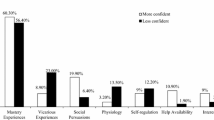Abstract
This study adapted the process feedback and outcome feedback scales of Jaworski and Maclnnis (1989) to investigate relationships between perceived parental feedback and birth order. A sample of 72 female and 80 male undergraduate business students was used. Firstborn/only children were hypothesized to report receiving more process feedback from parents, whereas last-borns were hypothesized to report receiving more outcome feedback. Results indicated that last-borns reported receiving significantly less of both types of feedback (process: p <.0029; outcome: p <.0009) than firstborns or middle children. No gender effects were found. Results thus suggest differential receipt of parental feedback as one possible basis for apparent birth order effects in societally recognized achievement.
Similar content being viewed by others
References
ADAMS, B. N. (1972). Birth order: A critical review. Sociometry, 35(3), 411–439.
ADLER, A. (1920). The practice and theory of individual psychology. Patterson, NJ: Littlefield, Adams.
ALTUS, W. D. (1966). Birth order and its sequelae. Science, 151, 44–48.
BANDURA, A., & CERVONE, D. (1986). Differential engagement of self-reactive influences in cognitive motivation. Organizational Behavior and Human Decision Processes, 38, 92–113.
BEGLEY, T. M., & BOYD, D. P. (1987). A comparison of entrepreneurs and managers of small business firms. Journal of Management, 13, 99–108.
BOHMER, P., & SITTON, S. (1993). The influence of birth order and family size on notable American women’s selection of careers. The Psychological Record, 43, 375–380.
BOWEN, D. D., & HISRICH, R. D. (1986). The female entrepreneur: A career development perspective. Academy of Management Review, 11(2), 399.
CALDER, B., PHILLIPS, L. W., & TYBOUT, A. (1981). Designing research for application. Journal of Consumer Research, 8, 197–207.
CAMPBELL, D. J. (1988). Task complexity and strategy development: A review and conceptual analysis. Academy of Management Review, 13, 40–52.
CARLSON, L., & KANGUN, N. (1988). Demographic discontinuity: Another explanation for consumerism? The Journal of Consumer Affairs, 22(1), 55–73.
COHEN, D. (1985, March). Do first and later borns agree with psychologists? Paper presented at the annual meeting of the Southeastern Psychological Accnriatinn Atlanta Ha
EARLEY, P. C., NÒRTHCRAFT, G. B., LEE, C., & LITUCHY, T. R. (1990). Impact of process and outcome feedback on the relation of goal setting to task performance. Academy of Management Journal, 33(1), 88–89.
ERNST, E., & ANGST, J. (1983). Birth order: Its influence on personality. Berlin: Springer-Verlag.
FISHER, H. E. (1989). Evolution of human serial pairbonding. American Journal of Physical Anthropology, 78, 331–354.
GALTON, F. (1874). English men of science: The nature and nurture. London: Macmillan.
GARDNER, H. (1978). Developmental psychology: An introduction. Boston: Little, Brown & Co.
HENNING, M., & JARDIM, A. (1977). The managerial woman. Garden City, NY: Anchor Press/Doubleday.
HISRICH, R. D., & BRUSH, C. G. (1983). The woman entrepreneur: Characteristics and prescriptions for success. Lexington, MA: Lexington Books.
HOLLAND, J. L. (1973). Making vocational choices: A theory of careers. New York: Prentice Hall.
JAWORSKI, B. J., & MACINNIS, D. J. (1989). Marketing jobs and management controls: Toward a framework. Journal of Marketing Research, 26, 406–419.
KURTZ, D. L., BOONE, L. E., & FLEENOR, C. P. (1989). Ceo: Who gets to the top in America. East Lansing, ML: Michigan State University Press.
LOCKE, E. A., & LATHAM, G. P. (1990). A theory of goal setting and task performance. New York: Prentice-Hall.
LYNCH, R. M., & LYNCH, J. (1980). Birth order and vocational preference. Journal of Experimental Education, 49(1), 15–18.
MATSUI, T., OKADA, A., & INOSHITA, O. (1983). Mechanism of feedback affecting task performance: 1969–1980. Organizational Behavior and Human Performance, 31, 114–122.
MOORE, K. K., & COX, J. A. (1990, Winter). Doctor, lawyer…or Indian chief? The effects of birth order. Baylor Business Review, 18–21.
NEIDER, L. (1987). A preliminary investigation of female entrepreneurs in Florida. Journal of Small Business Management, 25(3), 22–29.
NETER, J., WASSERMAN, W., & KUTNER, H. K. (1989). Applied linear regression models. Homewood, Il: Irwin.
SCHOOLER, C. (1972). Birth order effects: Not here, not now! Psychological Bulletin, 80, 213–221.
SEXTON, D. L., & KENT, C. A. (1981). Female executives and entrepreneurs: A preliminary comparison. In K. Vesper (Ed.), Frontiers of entrepreneurship research (pp. 40–55). Wellesley, MA: Babson University Press.
STEELMAN, L. C. (1985). A tale of two variables: A review of the intellectual consequences of sibship size and birth order. Review of Educational Research, 55(3), 353–386.
SULLOWAY, F. J. (1990, February). Orthodoxy and innovation in science: The influence of birth order in a multivariate context. Paper presented at the meeting of the American Association for the Advancement of Science, New Orleans, La.
TERRY, W. S. (1989). Birth order and prominence in the history of psychology. The Psychological Record, 39, 333–337.
U. S. BUREAU OF CENSUS. (1992). Statistical abstract of the United States (112th ed.). Washington, DC: U. S. Government Printing Office.
VOCKELL, E. L, FELKER, D. W., & MILEY, C. H. (1973). Birth order research 1967–1971: Bibliography and index. Journal of Individual Psychology, 29, 39–53
WATKINS, J. M., & WATKINS, D. S. (1983). The female entrepreneur: Her background and determinants of business choice—some British data. In J. Hornaday, J. A. Timmons, & K. Vesper (Eds.), Frontiers of entrepreneurship research (pp. 271–288). Wellesley, MA: Babson University Press.
WOOD, R. E., & BANDURA, A. (1987). Impact of conceptions of ability on self-regulatory mechanisms and complex decision-making. Working paper series, 87-019, University of New South Wales, Australian Graduate School of Management.
ZAJONC, R. B., BARGH, J. A., BERBAUM, M. L., MARKUS, G. B., & MORELAND, R. L. (1991). One justified criticism plus three flawed analyses equals two unwarranted conclusions: A reply to Retherford and Sewell. American Sociological Review, 56, 159–165.
ZAJONC, R. B., & MARKUS, G. B. (1975). Birth order and intellectual development. Psychological Review, 82(1), 74–88.
Author information
Authors and Affiliations
Rights and permissions
About this article
Cite this article
Claxton, R.P. Empirical Relationships Between Birth Order and Two Types of Parental Feedback. Psychol Rec 44, 475–487 (1994). https://doi.org/10.1007/BF03395138
Published:
Issue Date:
DOI: https://doi.org/10.1007/BF03395138




